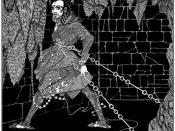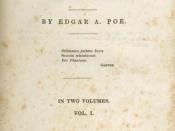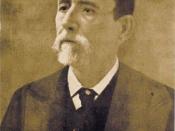Analysis of a Gothic Short Story by Poe In one of Poe's most famous short stories, The Cask of Amontillado, he details the narrator, Montressor's, pursuit of revenge on Fortunato, a pompous wine-connoisseur. Poe uses many literary devices in his analysis of Montressor's actions to illustrate the gothic-realism of Fortunato's death. Pride and revenge anchor this strange tale filled of irony and vivid, descriptive imagery. This particular story epitomizes Poe's work during the late nineteenth century, which has been put into two distinct categories as a part of his collection Tales of the Grotesque and Arabesque. The Cask of Amontillado falls into the category of the 'grotesque' which deals more realistically with human interaction because of the bizarre atmosphere and unpredictable plot developments.
Emotion and manipulation course through nearly every sentence of the story. Montressor's mode of revenge is very complex and interesting; he avenges himself by fooling Fortunato into literally walking into his own grave.
Montressor easily coerces Fortunato, the avid lover of wine, "through several suites of rooms to the archway that led into the vaults", containing the cask of Amontillado (Pg. 9). He continually asks whether Fortunato would like to leave thus creating a false sense of security, removing him of fear. This ultimately confuses Fortunato and leads into the irony of his death. Poe evokes emotions such as fear and amazement from the reader dually, while leading Fortunato into the vault with such careful manipulation by Montressor. This juxtaposition of such extreme and polar feelings, fear and amazement, frustrates the reader as it foreshadows Fortunato's fate. Another example of irony comes in the statement made by Montressor that he and Fortunato ought to return from the "damp ground of the catacombs" because Fortunato's "health is precious" (pg. 9).
Poe illustrates the dreary and enclosed nature of the descent into the vault through Montressor's poignant narrative; "We had passed through walls of piled bones, with casks and puncheons intermingling into the inmost recesses of the catacombs" (pg. 10). Poe fulfills the several requirements of gothic writing by establishing a gloomy, dark, and threatening tone as well as strange and melodramatic events in the plot. These detailed descriptions; "...descending again, arrived at a deep crypt, in which the foulness of the air caused our flambeaux rather to glow than flame", execute the techniques used to achieve a gothic tone (pg. 11). Upon their arrival into the crypt, where Montressor leads his victim towards a small recess in the wall, he methodically begins the process of encasing Fortunato alive. At this moment, Fortunato realizes his fate; fear and panic set in with a "low moaning cry from the depth of the recess . . . not the cry of a drunken man" (pg. 13). Montressor's narrative as he commits Fortunato to his death continues with a constant eerie perseverance. The narrative ends with the Latin phrase: "In pace requiescat!" (Pg. 14), meaning "May he rest in peace." This appears to be Montressor's morbid and twisted means of closure ending his involvement with Fortunato.
Poe's ability to create such a disturbingly intense story, instilling a sense of fear and terror in the reader, with his tight grip of the language and controlled sentence structure, in a limited eight pages proves his talent as a one of the great modern authors of gothic literature. His careful use of irony and skill of incorporating images that engage all senses, further develop the theme of revenge and retribution. The conflict of intellectual struggle between Montressor and Fortunato combined with the physical events that take place in The Cask of Amontillado embody the principles of gothic literature.





